| |
|
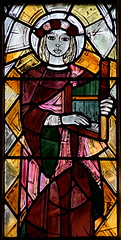 |
|
Withersfield sits not far
from the busy town of Haverhill in that
little peninisula of Suffolk jutting out
into Cambridgeshire and Essex. The pretty
name of the village comes from the
ancient practice of enclosing a large
area for wether sheep (that is to say,
castrated males kept for their wool) to
roam fairly freely during the summer
months. The prefix occurs three times in
Suffolk village names, here, again at
Withersdale in the far north, and also at
Withermarsh in the south east. In all
three cases, it is open ground near to a
larger settlement.
St Mary is set in the heart of the
village near to an ancient crossroads.
The church begins a theme that will be
common as you move east of here, for the
stair turret rises above the battlements
of the 15th century tower, which, with
the dedication, will become a motif of
the Stour valley. Seen from the road, the
south side arrangement of battlements,
clerestory and aisle appears the very
model of Suffolk perpendicular. In fact,
this is an illusion, for just about
everything you see is Victorian, only the
clerestory being medieval. Even the
chancel was rebuilt at this time. The
oldest survival in the entire building,
however, can be seen without even going
inside. The door handle, with its two
Harry Potterish dragons, survives from
the 13th century church.
|
St Mary is most famous for its bench
ends. They line the north ends of the south nave
benches. The most easterly is the image of St
George defeating the dragon, the serpent writhing
in agony beneath the knight's horse's hooves.
Among those to the west of it are a perky little
mermaid, a pelican in her piety, a swan wearing a
collar and two bears fighting amongs foliage. At
the far west is St Michael weighing souls. A man
kneels in the right hand bucket of the balance,
and his sins are measured against him in the left
hand balance in the form of a malevolent little
creature. Although this image is familiar from
medieval dooms, it is particularly interesting
here. On the extreme left, the devil has appeared
on the scene, and is holding the evil side up
before letting it drop. Only the power of prayer
will get the just man out of this, and so he
clings tightly to his rosary beads. I wonder if
post-Reformation Withersfielders took the image
to mean that such Catholic ritualist practices as
praying with a rosary would be bound to land a
man in hell.
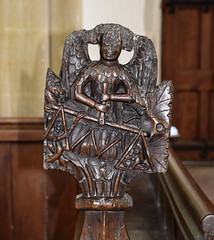 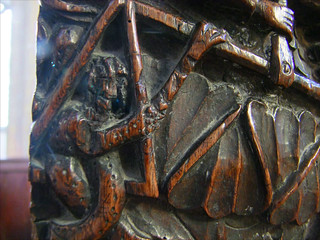 
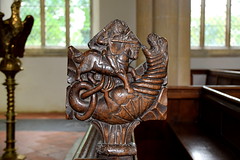 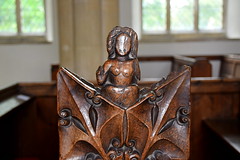 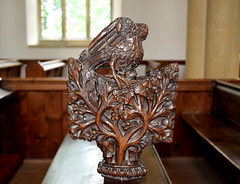 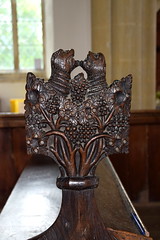 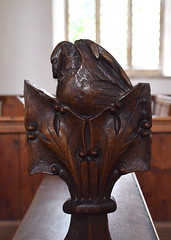
Pippa Blackall's characteristically
lovely window of St Cecilia sits in the north
aisle east window. Beside it, guarding the
entrance to the Victorian chancel is one of the
best 15th century rood screens in the area. The
doors, a feature of this area, are similar to
those at Cowlinge. Mythical and heraldic
creatures haunt the spandrels, but there are no
saints below for the screen was repainted in the
rather gaudy fashion of the 18th century, at
which time it was adorned with cherub heads and
foliage. This ought to be awful, but somehow it
works, although of course you wouldn't want it
everywhere. Interestingly, this restoration of
the screen might suggest that the chancel was in
use for worship in the 18th century.
Another mystery is up in the roof of
the nave. This was entirely reconstructed in the
1980s, but the hammerbeams survive from the
medieval roof, and appear to be unfinished; a
couple have figures on, but one has an unfinished
figure, while another has curious markings and
what may be the fixing for an angel.
There is nothing mysterious
about the north aisle roof for this is a
mellow, beautiful piece, with curious
bosses including a man's face which is
deliberately aslant, and an eagle. It
dates from just after 1480, and the brass
at the extreme east is for the donor,
Robert Wyburgh.
The elegant tower arch rises above the
font, and Miss Heylen's plaque claiming
the front bench for Hanchet Hall in 1810.
The typically rustic parish charity board
is charming, not least because the parish
name appears to have been painted out at
some point, probably during the Second
World War. Also, there is a great
curiosity behind the south door. It
appears to be an arcade capital turned
into a holy water stoup. It must be
earlier from the south arcade, removed
when the aisle was rebuilt. Yet another
sign that the Victorians' great
enthusiasm for this place was all done
rather well. |
|
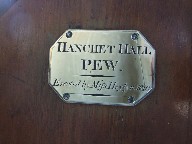 |
|
|
|

